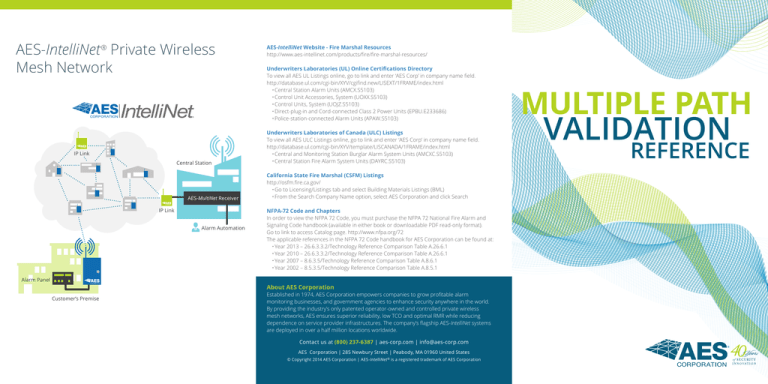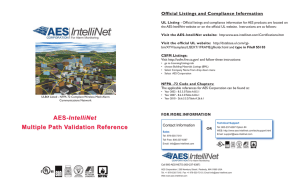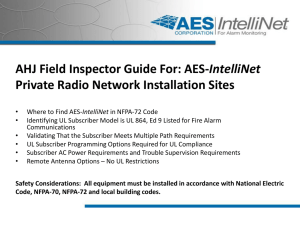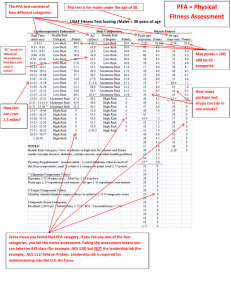AES-IntelliNet® Private Wireless Mesh Network
advertisement

AES-IntelliNet® Private Wireless Mesh Network IP Link Central Station AES-MultiNet Receiver IP Link Alarm Automation AES-IntelliNet Website - Fire Marshal Resources http://www.aes-intellinet.com/products/fire/fire-marshal-resources/ Underwriters Laboratories (UL) Online Certifications Directory To view all AES UL Listings online, go to link and enter ‘AES Corp’ in company name field. http://database.ul.com/cgi-bin/XYV/cgifind.new/LISEXT/1FRAME/index.html •Central Station Alarm Units (AMCX.S5103) •Control Unit Accessories, System (UOXX.S5103) •Control Units, System (UOJZ.S5103) •Direct-plug-in and Cord-connected Class 2 Power Units (EPBU.E233686) •Police-station-connected Alarm Units (APAW.S5103) Underwriters Laboratories of Canada (ULC) Listings To view all AES ULC Listings online, go to link and enter ‘AES Corp’ in company name field. http://database.ul.com/cgi-bin/XYV/template/LISCANADA/1FRAME/index.html •Central and Monitoring Station Burglar Alarm System Units (AMCXC.S5103) •Central Station Fire Alarm System Units (DAYRC.S5103) California State Fire Marshal (CSFM) Listings http://osfm.fire.ca.gov/ •Go to Licensing/Listings tab and select Building Materials Listings (BML) •From the Search Company Name option, select AES Corporation and click Search NFPA-72 Code and Chapters In order to view the NFPA 72 Code, you must purchase the NFPA 72 National Fire Alarm and Signaling Code handbook (available in either book or downloadable PDF read-only format). Go to link to access Catalog page. http://www.nfpa.org/72 The applicable references in the NFPA 72 Code handbook for AES Corporation can be found at: •Year 2013 – 26.6.3.3.2/Technology Reference Comparison Table A.26.6.1 •Year 2010 – 26.6.3.3.2/Technology Reference Comparison Table A.26.6.1 •Year 2007 – 8.6.3.5/Technology Reference Comparison Table A.8.6.1 •Year 2002 – 8.5.3.5/Technology Reference Comparison Table A.8.5.1 Alarm Panel About AES Corporation Customer’s Premise Established in 1974, AES Corporation empowers companies to grow profitable alarm monitoring businesses, and government agencies to enhance security anywhere in the world. By providing the industry’s only patented operator-owned and controlled private wireless mesh networks, AES ensures superior reliability, low TCO and optimal RMR while reducing dependence on service provider infrastructures. The company’s flagship AES-IntelliNet systems are deployed in over a half million locations worldwide. Contact us at (800) 237-6387 | aes-corp.com | info@aes-corp.com AES Corporation | 285 Newbury Street | Peabody, MA 01960 United States © Copyright 2014 AES Corporation | AES-IntelliNet® is a registered trademark of AES Corporation The Shortest, Most Reliable Route for Alarm Signals The purpose of this document is to provide information on how to validate the multiple paths used from a given protected premises location to the dispatch center and to define terminologies used when describing the functionality of AES-IntelliNet mesh critical event communications technology. AES-IntelliNet Multi-Path Concept AES-IntelliNet is a wireless mesh network made up of subscriber units each acting as a receiver, transmitter and repeater. Each protected premises outfitted with an AES subscriber is linked to the AES-IntelliNet network by this subscriber unit. The network allows distant subscriber units to use one of many other subscriber units to relay the alarm message to the network receiver hub. Signals follow the shortest, most reliable route of all the available path options at that moment, ensuring fast, reliable alarm communications. An explanation of some of the technical terms used in other documentation is provided later in this document. Multiple Path Validation Process. All fire Alarm installations require 2 paths which is validated on AES-IntelliNet with a NETCON reading of 7, 6, or 5.To validate that an AES subscriber has multiple paths of communications available to it, please conduct the following with your handheld (HH) programmer: •Step 1: Connect HH programmer to subscriber •Step 2: Press F4 or Ctrl T to view routing table •Step 3: See if the table shows a NetCon of 7, 6, or 5 The display should look something like this: 4.5678,L:02,N:5,Q:03 Unit 5678, Good signal (03) 3.7888,L:01,N:5,Q:03 Unit 7888, Good Signal, Neighbor 2.2222,L:00,N:0,Q:03 IPLink 2222, Good Signal (03, 02) 1.1111,L:00,N:0,Q:03 IPLink 1111, Our Number one These footnotes explain the above routing table readings 4 - indicates routing table path #4 5678 - ID of the first subscriber in the pathway of this radio L:02 - link layer of 2 - this path requires 2 “hops” to receiver N:5 - indicates this path has a NETCON of 5 Q:03 - this path has a good signal quality Reference Definitions Technical terms relating to multiple path communications described in this document are described below. AES Corporation UL/NFPA Compliance Chart AES-IntelliNet® products and services meet official UL listings and NFPA compliance requirements as shown below: Link Layer Also described as “Level” on the handheld programmer, indicates number of “hops” the message packet must make to reach the network receiver hub. In general, Level 1 directly connects to the network receiver hub, Level 2 connects through one subscriber to network receiver hub, Level 3 connects through 2 subscribers to network receiver hub. Battery Backup Required Supervision Inputs? Required Check-In Intervals Proprietary Fire (UL864/NFPA72, UOJZ, UOJZ7, IPXX&) 24 hours 24 hours RT1 Refers to the “first route” or primary route in the routing table. Remote Central Station (UL864/NFPA72, UOJZ, UOJZ7, UOXX, UOXX7) 24 hours 24 hours Dynamic Routing Table This function provides a real time “peer list” of network devices which the subscriber being tested communicates with as well as the order in which they will be used for communication to the dispatch center. Type 6 Fire 24 hours 24 hours Type 7 Fire 24 hours 24 hours NETCON “NETwork CONnectivity.” This is an internal rating function used by the AES-IntelliNet subscriber units to maintain their place in the network. A Netcon Rating of 5 indicates that multiple paths of Communication to the dispatch center are in place. AHJ Notes When using AES, is a second method of transmission required? (DACT, DER Chnl, MPX) AES-IntelliNet Compliance Details 1. Battery Backup All AES-IntelliNet subscribers will support the battery storage required to meet all UL requirements. 2. Supervision Inputs The discrete zone inputs of AES-IntelliNet subscribers are electronically supervised through programming options in accordance with UL requirements. 3. Required Check-in Intervals Check-In intervals of no more than 24 hours from the protected premises to the dispatch center are UL approved and NFPA-72 compliant. 4. Compliant Without Second Method of Signaling Primary standalone communications for individual AES-IntelliNet subscribers is achieved through communications with multiple network nodes. As many as 8 unique paths of communications will be displayed by individual subscribers via the AES routing tables. A NETCON of 5 for the subscriber ensures dual communication paths which satisfies UL/NFPA compliance from the premises. • Proprietary Fire • Central Station Fire • Remote Station Fire



